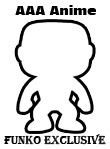Anime News
|
Militant Cute and Sexy Politics in Japanese Moe Comics Date: 11/13/2009 |
|
The Japanese catchphrase moe means "budding," mostly applied to young girls. But it's also part of Japanese political satire - in moe comics, the U.S. military and war-torn countries of Central Asia are represented as cute girls and metrosexual boys. If phatic language is language which smooths over social tasks and reassures us rather than conveying information ("How's it going?" "Good, how about you?"), then phatic images are images which smooth over social issues, and they are one of Japan's biggest exports. From Hello Kitty to Pok?mon to any number of big-eyed franchises, the Japanese love of kawaii (cuteness) is well known, parodied as just another weird Japanese thing in the Mister Sparkle episode of the Simpsons, but perhaps part of a common human urge. "We humans are a self-centered race," said Scott McCloud in Understanding Comics. To prove his point, McCloud drew a series of abstract squiggly shapes, then turned them into faces by adding a single element to each one: an eye. Instantly, the weird lines became noses and mouths, the random shapes turned into goofy faces. It's comforting to imagine nonhuman things as humans, whether they're toys or vehicles, foods or animals, or Pipo-kun, the mascot of the Tokyo police force. For corporate mascots and advertising characters, the cuteness softens the message. To quote Mary Poppins, "a spoonful of sugar helps the medicine go down." A little sex in the sugar is even smoother. The male-dominated world of hardcore anime and manga fans had always had a taste for cheesecake, but in the '80s it had more of a science fiction and mecha edge; now, the girls themselves were growing in importance, as cutesy tweens and teens did cute things in shows like Azumanga Daioh (beloved by both 13-year-olds and grown men) and a variety of more "adult" anime and manga continuing the dubious tradition of the early '80s lolicon ("Lolita Complex") anime/manga subculture. Oldschool fans grumbled, bemoaning the loss of their hard sci-fi and their Gundam military action, but the kawaii-ization and, arguably, infantilization of geek culture marched on. Di Gi Charat, a 1998 gag manga about the green-haired, cat-eared, maid-outfit-wearing corporate mascot of the "Gamers" store chain, became popular enough to be spun off into a series of graphic novels and anime shows-the equivalent of a TV show based on Ronald McDonald and the Hamburglar. But Digiko merely worked at Gamers - she represented a cute, maid-outfit-wearing Gamers employee, not Gamers itself. On message boards and drawing desks, geek culture soon developed an even purer expression of cuteness, moe anthropomorphism, the representation of inanimate objects or concepts as cute girls. What better way to dress up boring, abstract concepts? Fans created Wikipe-tan, a character representing Wikipedia, and the OS-tans, based on various operating systems: a cat-themed Mac OS X girl, a gnu-horn-wearing Linux girl, etc. ("Tan" is the Japanese suffix "-chan" pronounced in a cutesy baby voice.) Nothing was safe from anthropomorphism. In Bincho-tan, the characters represent different kinds of charcoal. Demonbane reimagined the evil books of H.P. Lovecraft's Cthulhu Mythos, including the Necronomicon, as cute girls-the better to bond with the sorcerers who 'read' them, of course. Maru Asakura's manga 090 Eko to Issho ("090 Eko and Me") is a romantic comedy about cellphones who turn into girls. Like Life, a pornographic computer game "visual novel," features girls based not just on cell phones but vacuum cleaners, coffee pots, refrigerators and traffic lights-talk about objectification. The predominant moe culture is one of sweetness and light and panty shots, but Japanese military & robot fans did not miss the moe bandwagon for long. Among the countless anthropomorphic experiments were robotized girls, aka mecha musume, made up of girls crossed with heavy equipment, robots, tanks, planes, etc. Cyborg doll/machine women have always had a huge following, and somewhere there must be a missing link between Battle Angel Alita's Gally, Ghost in the Shell's Major Kusanagi and Vikusen's Loli Airplane Machine. Humikane Shimada, who coined the term "mecha musume," hit every fetish imaginable with Strike Witches, an alternate-universe WWII story whose heroes are young girls (check), magic-users (check), with animal ears and tails (check), who wear WWII airplane propellers on their legs like Transformers amputees or cybernetic stocking-fetishists (check, check, check, CHECK). The magazine MC Axis, launched in 2006, focuses exclusively on the sexualized linkage of women's bodies and military weaponry. Compared to this stuff, Yukio Hirai's Pixel Maritan is a mili-moe (military moe) manga you could show to your grandfather. The pink-haired Maritan, who first appeared in 2005 in a book/CD set intended to teach Japanese readers how to speak colloquial English, is the cartoon representation of the U.S. Marine Corps. Maritan's purpose is to teach Japanese fans how to swear like a Marine, through adorably testosterone-packed gag comics. "It's fucking English time!" reads the cover text on one of the several Maritan books. Within, you can learn phrases like "Your puny little ass is mine!" and "To show our appreciation for so much power, Marines keep heaven packed with fresh souls!", translated by actual Marine Corps members stationed in Japan. Lightly digitized pictures of Osama Bin Laden and Saddam Hussein (Maritan's enemies) are common, and a photo section in the back shows Japanese women hanging out with Marines and riding tanks and so on. According to a friend who works on the series, the Marines stationed in Japan are generally fond of Maritan and eagerly contribute to all this. Maritan's origin story is a parody of so-called mah? shojo "magical girl" shows (like Sailor Moon), in which the heroine usually visits Earth from some fairy realm on a mission of good. In Maritan, the title character comes from the magical realm of Paris Island and introduces herself by crashing a fighter jet into the house of the "Japanese" character. Soon we meet Army-kun (a "dogface" private with dog ears), Navy-san and Jiei-tan, a diligent girl with glasses who represents the Japanese Self-Defense Force. |
| Source: io9 |






















